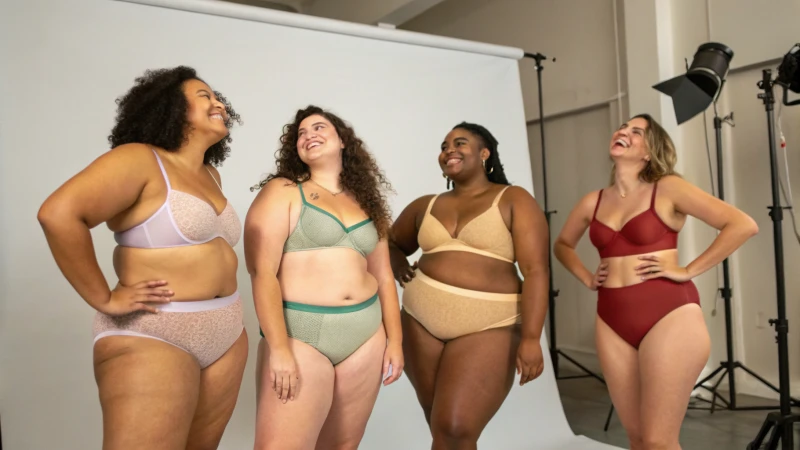
Starting my own underwear brand felt like stepping into a thrilling new world, one filled with endless possibilities and some hurdles to overcome.
To successfully set up your own underwear brand, focus on defining your brand identity, conducting thorough market research, and crafting high-quality product designs. Develop a solid online presence and execute a strategic marketing plan to reach your target audience effectively.
While these initial steps lay the groundwork, there's so much more to consider to ensure my brand's success. From creating samples to iterating based on customer feedback, every detail matters in carving out my niche in this competitive market.
Market research is optional for starting an underwear brand.False
Market research is crucial to identify target demographics, competitors, and market gaps.
What Are the Key Steps in Defining Your Brand Identity?
Your brand identity is the essence of your company, shaping how customers perceive you.
Defining your brand identity involves understanding your target audience, pinpointing your brand values, and crafting a consistent visual and verbal language that resonates with your market. These steps ensure a cohesive image and foster trust and recognition among consumers.

Understanding Your Target Audience
Knowing who your customers are is crucial. Start by identifying their demographics, preferences, and shopping behaviors. This information helps tailor your brand's messaging and design to appeal directly to them. For example, if you're targeting eco-conscious consumers, emphasize sustainability in your brand values1.
Pinpointing Brand Values
Brand values are the guiding principles that dictate every aspect of your business, from customer service to marketing campaigns. Determine what matters most to your company and how you want to be perceived. These values should align with those of your target audience to create a stronger emotional connection.
Crafting Your Unique Selling Proposition (USP)
Your USP sets you apart from competitors. It’s a clear statement that describes the unique benefit of your product or service. Is it the quality, price, style, or something else? A well-defined USP can be a powerful tool in attracting and retaining customers.
Developing a Visual and Verbal Language
A consistent visual identity includes elements like your logo, color scheme, typography, and imagery style. This visual language should be complemented by a verbal identity, which includes tone of voice, messaging, and storytelling style. Both need to be cohesive across all platforms to strengthen brand recognition. Use branding guidelines2 to maintain this consistency.
Building Brand Recognition
Once you've established these elements, it's important to build recognition through strategic marketing efforts. This includes everything from social media campaigns to content marketing. Ensuring that every piece of communication reflects your brand identity will help you establish a strong market presence over time.
Understanding your audience is key to brand identity.True
Knowing customer demographics and preferences tailors brand messaging.
Brand values should differ from target audience values.False
Aligning brand values with audience strengthens emotional connections.
How Can You Conduct Effective Market Research for Your Underwear Brand?
Understanding the market is crucial for the success of your underwear brand.
To conduct effective market research for your underwear brand, start by analyzing your target demographic, studying competitors, and identifying market gaps. Utilize surveys, focus groups, and social media insights to gather valuable data that will inform your brand strategy.

Understanding Your Target Audience
Before diving into product creation, it's imperative to understand who will buy your product3. Start by defining your target demographic. Are you designing for men, women, or both? Consider age, lifestyle, and even geographic location. Knowing your audience informs not only design but also marketing strategies.
Conduct surveys or focus groups to gather first-hand data on consumer preferences. Questions can include preferences on fabric, fit, and price point. Online tools like Google Forms or SurveyMonkey can facilitate this process efficiently.
Analyzing Competitors
Understanding your competition is another crucial aspect of market research. Identify key players in the underwear industry and analyze their product offerings, marketing strategies, and customer reviews. Platforms like Amazon or social media sites can provide insights into what competitors are doing well and areas where they might be lacking.
Create a comparative table to list competitors’ strengths and weaknesses:
| Competitor | Strengths | Weaknesses |
|---|---|---|
| Competitor A | High-quality fabric | Limited size range |
| Competitor B | Strong online presence | Higher price point |
| Competitor C | Innovative designs | Slow delivery times |
Identifying Market Gaps
By combining insights about your target audience with competitor analysis, you can identify gaps in the market. Perhaps there is a demand for sustainable materials or inclusive sizing that is currently unmet.
Use keyword research tools to understand what potential customers are searching for online. This information can guide you in positioning your brand uniquely within the marketplace.
Utilizing Social Media Insights
Social media platforms are treasure troves of consumer insights. Analyze comments, likes, and shares related to underwear brands to gauge public opinion. Tools like Hootsuite or Sprout Social can help manage and analyze social media data effectively.
Don't just look at your direct competitors—examine adjacent markets such as loungewear or activewear for broader trends that could influence your designs.
By leveraging these various research methods, you’ll be better equipped to tailor your products and marketing strategies to fit market demands.
Analyzing competitors helps identify market gaps.True
Competitor analysis reveals unmet demands and opportunities.
Surveys are ineffective for gathering consumer preferences.False
Surveys provide direct insights into consumer needs and desires.
What Should You Consider When Designing Your Product Line?
Designing a product line is a creative process that requires careful consideration of several key factors.
When designing your product line, consider the brand identity, target market preferences, quality materials, and sustainable practices. These elements ensure a product line that resonates with your audience and stands out in the market.

Understanding Your Brand Identity
Before diving into the design specifics, it's crucial to align your product line with your overall brand identity4. Ask yourself what values and messages your brand aims to convey. This will guide design choices, ensuring cohesion across all products.
Analyzing Market Trends
Staying informed about current market trends is imperative. Investigate what styles and designs are gaining popularity within your niche. This can be done through fashion shows, industry reports, and competitor analysis.
Selecting Quality Materials
The choice of materials directly affects the product's durability and comfort. Opt for fabrics that not only feel good against the skin but also withstand regular wear and tear. Consider eco-friendly options to appeal to environmentally conscious consumers.
| Material | Benefits | Drawbacks |
|---|---|---|
| Organic Cotton | Breathable, hypoallergenic | Higher cost |
| Bamboo Fiber | Soft, antibacterial, moisture-wicking | Limited color options |
| Recycled Nylon | Sustainable, high performance | May not be as soft as natural fibers |
Designing for Functionality
Aesthetics are important, but functionality should not be overlooked. Ensure that your designs provide the right fit and support. Conducting wear tests with diverse body types can highlight any areas needing improvement.
Embracing Sustainable Practices
In today's market, sustainability is more than just a trend; it's a necessity. Incorporate sustainable practices into your design process by minimizing waste, using recycled materials, and choosing ethical production partners.
Creating Prototypes and Testing
Once you have a design concept, create prototypes to test their feasibility. This phase allows you to make necessary adjustments before mass production. Gather feedback from potential customers to refine your designs further.
By focusing on these considerations, you can craft a product line that not only meets consumer demands but also aligns with your brand ethos.
Brand identity should guide product design choices.True
Aligning with brand identity ensures cohesion across the product line.
Sustainability is optional in modern product design.False
Sustainability is now a necessity, not just a trend, in design.
How Can You Build a Strong Online Presence for Your Brand?
A robust online presence is crucial for brand success in today's digital age.
To build a strong online presence for your brand, create a user-friendly website, leverage social media platforms, and implement an effective SEO strategy. Engage with your audience through consistent and authentic content to enhance visibility and foster brand loyalty.

Establishing a User-Friendly Website
Your website is often the first point of contact for potential customers. It should be visually appealing, easy to navigate, and mobile-friendly. Consider using website-building tools5 that offer customizable templates to ensure your site reflects your brand's identity. Regularly update your website with fresh content to keep visitors engaged and informed.
Leveraging Social Media Platforms
Social media is a powerful tool for connecting with your audience. Identify which platforms your target market frequents, such as Instagram for visual content or LinkedIn for professional engagement. Share authentic and engaging content regularly, and interact with followers to build a community around your brand. Use analytics tools to track engagement and refine your strategy.
Implementing SEO Strategies
Search Engine Optimization (SEO) enhances your website's visibility on search engines. Use relevant keywords throughout your site and in blog posts to improve ranking. Regularly update your content to reflect current trends and maintain a high SEO score. Tools like SEO plugins6 can assist in optimizing content and tracking performance.
Engaging Content Creation
Content is king when it comes to building an online presence. Create diverse content such as blogs, videos, and infographics that provide value to your audience. Authenticity is key; share your brand's story, values, and insights to connect with users on a personal level. Encourage user-generated content by hosting contests or featuring customer stories.
Consistent Brand Messaging
Ensure that all your online platforms convey a consistent brand message. From the tone of your social media posts to the design elements on your website, consistency fosters trust and recognition. Use branding guidelines to maintain uniformity across different channels, making it easier for customers to recognize and relate to your brand.
Incorporating these strategies effectively will not only enhance your brand's online presence but also strengthen customer relationships and drive sales. For more insights into optimizing digital marketing efforts, explore resources on digital marketing strategies7.
SEO strategies improve website visibility.True
SEO uses keywords and updates to boost search engine rankings.
Social media is ineffective for brand engagement.False
Social media connects brands with audiences, enhancing engagement.
Conclusion
Reflecting on these insights can be the catalyst for launching my dream underwear brand. It's time to take action!
Explore how aligning values strengthens customer connections.: If the values your brand represents are not aligned to the values of your target customer, no amount of marketing will move them to your brand. Customers build ... ↩
Learn how to develop cohesive branding elements.: Define the brand. · Articulate the mission statement. · Explain the name and tagline. · Identify the voice and tone. · Introduce the intended audience. ↩
Learn techniques to pinpoint your brand's ideal customer base.: A target audience is a specific group of people who are most likely to be interested in and benefit from your product, service, or message. ↩
Learn effective strategies for defining a strong brand identity.: It refers to the unique characteristics that influence a brand's perceived personality, appearance, and behavior. A brand's identity encompasses ... ↩
Discover top tools to create an attractive, user-friendly brand website.: We've narrowed down our list to the top five small business website builders and Shopify is the best overall. It offers unbeatable ecommerce features. ↩
Learn about effective SEO plugins to boost website visibility.: Smartcrawl is the best in my opinion. I've tried pretty much all of them, across almost a hundred client sites. The free version does everything ... ↩
Explore comprehensive strategies to enhance brand visibility online.: Search Engine Optimization (SEO) is an important digital marketing strategy as it can make your brand, product or service more visible online. ↩






